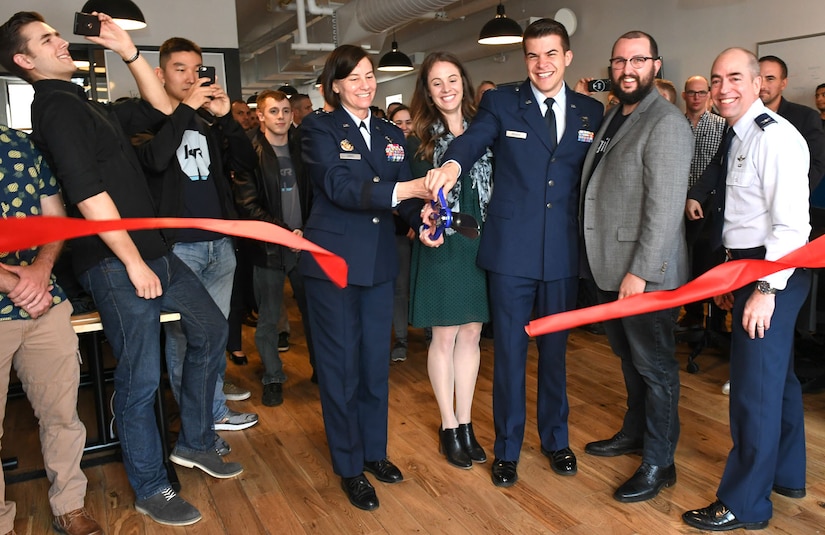By Benjamin Newell, 66th Air Base Group
BOSTON -- Thirty active duty airmen, Air Force civilians and
contractors gathered in a shared workspace here May 7 for the opening of the
Kessel Run Experimentation Lab, where they will build the next generation of
combat software.
WeWork’s shared innovation space in Boston’s North End is
usually home to constantly shifting startup companies, but the
T-shirt-and-jeans-wearing airmen milling around its fully-stocked kitchenette
sounded a bit different from their similarly dressed office mates. Instead of
compound annual growth rate, or return on investment, they used terms such as
“kill chain integration” and “battle damage assessment.” This shared space,
occupied by a smattering of startups, will also serve as the Air Force's KREL.
“It’s one thing to say you’re going to do business
differently,” said Air Force Maj. Gen. Sarah Zabel, the Air Force’s director of
information technology acquisition process development at the Pentagon. “But
look around and you can see that these airmen are learning. They’re building
actual products, and they’re writing the book on how to be combat engineers for
the information age.”
Zabel cut the ribbon for the 90-seat facility, complete with
open floor plans, paired workstations and small, private offices where teams tackle
technological hurdles faced by warfighters. Some of the airmen now working in
KREL served in air operations centers, where, at the time, complex plans for
refueling operations were written by hand; transcribed into common office
applications not designed for the task; or shouted across a busy room.
Nothing Like It
“I’ve never seen anything like this project in 16 years with
the Air Force,” said Air Force Tech. Sgt. Steven Wingrove, an analyst with the
324th Intelligence Squadron at Joint Base Pearl Harbor-Hickam, Hawaii, who is
on temporary assignment to KREL. “Purposely designing applications so that
systems work for us is so important. I volunteered to come here because I
really think there’s an opportunity to impact combat. That’s at the center of what
we’re doing.”
Wingrove, like many at KREL, has a technology background. He
codes in his free time and applied his HTML and Javascript knowledge to improve
his unit’s SharePoint site. In the Air Force, where he’s a valuable asset, only
about 300 airmen are dedicated software engineers.
Project Kessel Run is managed by the Air Force Life Cycle
Management Center’s battle management directorate at Hanscom Air Force Base,
Massachusetts. AFLCMC oversees sustainment and upgrade of the Air Operations
Center.
The AOC weapons system consists of a series of applications,
computer functions and Airmen who orchestrate combat airpower. The AOC 10.1
team sustains the fielded baseline and keeps existing systems functional, which
allows Kessel Run personnel to focus on modernization. Project Kessel Run’s
initial focus was improving the AOC that oversees most air combat in the Middle
East. Now they are expanding to the entire AOC enterprise across the globe,
including an eight-region cloud platform and the stand-up of 10 additional
application teams by the end of the year.
‘Building Better Systems’
“We’re all consumers of this software,” said Michael, a
civilian intelligence analyst with the 15th Intelligence Squadron at Joint Base
Langley-Eustis, Virginia, on his first day at KREL. “Sometimes your job is just
to make a system that is 15 years old work for you today. Hopefully, we’re
starting down the road of building better systems that we can go forward and
use ourselves.” (Michael’s last name is withheld for security reasons.)
Michael and Wingrove are both on six-month temporary
assignments to Project Kessel Run. They’ll spend a short time in Boston,
orienting themselves at the KREL space. Then, they’ll be sent to Washington,
San Francisco; or Cambridge, Massachusetts, to be paired off with software
professionals who are on contract to train airmen in building custom programs.
Finally, they’ll come back to KREL to work with airmen at a type of Air Force
software factory.
Three contracting and program specialists from Hanscom Air
Force Base worked a series of other transaction authorities, sole-source
contracts and small business contracts to get Project Kessel Run off the
ground. KREL is the latest step. The space in which Kessel Run airmen will ply
their knowledge includes resources and facilities rivaling the fastest-growing
software startups, giving Air Force developers access to the tech sector
culture that has revolutionized modern life.
The OTA with Pivotal Inc., which paired airmen and leading
commercial practitioners, began in August. Then, with airmen ready to
"graduate" from Pivotal Labs, the team worked with a software
development company called TDMK Digital, which set up the turnkey software
development environment at KREL. TDMK subcontracted WeWork's Boston space and provided
the hardware, digital connections and resources necessary for 90 work spaces at
one-year cost to the government of $1.6 million. There is an option to exercise
next year for $1.5 million.
Scaling Up
“[The] bottom line is we’ve proved the acquisition side of
the house can keep pace with the technology side of the house,” said Kevin
Dolan, a battle management program manager assigned to Kessel Run. “We’re
exclusively supporting this effort, and it’s a real startup feeling. A year
ago, there was one product. Since then, we’ve scaled to eight product teams,
looking at supporting 18 by the end of the year and more than 30 by the end of
2020.”
The Boston space is modeled after the Pivotal Labs training
locations in Cambridge; San Francisco; and Washington, which are home to
similar innovation hubs. The airmen in the Boston offices share space with
startups. Major tech firms also deploy small teams to these types of shared
work spaces to cross-pollinate with the type of innovation occurring.
“No matter where these airmen are working, they’re working
for combatant commanders and warfighters,” Zabel said. “You can count on these
airmen to be in contact with the warfighter’s edge, and to see where a
difference can be made. They can see and articulate what needs to change, and
they have the will, and now the experience, to see it done.”








No comments:
Post a Comment